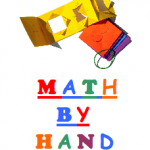 One of the most valuable concepts I learned as a Waldorf teacher was that “breathing out” is as (or more) essential to successful teaching and learning as “breathing in” is. Recreational time or time out from learning is absolutely crucial to every student’s health, well-being, and true educational success. The good news is that your homeschool math curriculum can breathe!
One of the most valuable concepts I learned as a Waldorf teacher was that “breathing out” is as (or more) essential to successful teaching and learning as “breathing in” is. Recreational time or time out from learning is absolutely crucial to every student’s health, well-being, and true educational success. The good news is that your homeschool math curriculum can breathe!
Adopting a program like Math By Hand ensures that your students will not only have good, healthy fun in between their math lessons but during them as well. Taking time out from a math lesson or pencil-and-paper practice by having students do jumping jacks is one thing. But what if your homeschool math curriculum was so lively, fun, and invigorating that there was no need to take this sort of time out from it? Now that’s a truly successful math program!
We have only to witness the effects of cutbacks in our schools’ arts and PE programs to note how mistaken the notion of “more academics is better” can be. And nowhere is this notion more apparent than in China’s school system. Yong Zhao, the Associate Dean of the University of Oregon, writes in his 12/10/10 blog that the staggering hours of schoolwork and homework that are expected of top Chinese students (especially middle school and high school students) may be backfiring. See the full blog entry at: http://yong-zhao.com/2010/12/10/a-true-wake-up-call-for-arne-duncan-the-real-reason-behind-chinese-students-top-pisa-performance/)
He notes that “Chinese students (a sample from Shanghai) outscored 64 countries/education systems on the most recent PISA, OECD’s international academic assessment for 15 year olds in math, reading, and science.” He wonders why international education experts were so impressed by this statistic since, “It is no news that the Chinese education system is excellent in preparing outstanding test takers, just like other education systems within the Confucian cultural circle—Singapore, Korea, Japan, and Hong Kong.”
Zhao goes on to say that this news did not make a big splash in any of China’s major media outlets. He searched extensively but did not find any mention of this outstanding achievement. What he did find instead was a story from a Chinese middle schooler’s mother that is both shocking and sad, and may provide the real reason behind the outstanding performance of top students in China. It “follows a mother’s online posting, complaining about how her child’s school’s excessive academic load has caused serious physical and psychological damage.”
The article details the grueling work load and unreasonable expectations that are piled on the vulnerable shoulders of these youngsters. The online post says that her daughter’s 7th grade middle school schedule included extra evening classes that ended at 6:30pm. But that since entering 9th grade, her evening classes have been extended to 8:40pm every day, and that 12th graders are also required to take additional classes from 7:30am to 8:00pm on Saturdays.
There are 5 weeks of classes during winter and summer school vacations, and the long school days do not include any self-study time or physical education classes. The mother adds, “After coming home after 10pm, she has to spend at least one hour on her homework. She has to get up at 5am. She is still a child. May I ask how many adults could endure this kind of work? This kind of practice has seriously damaged students’ health. They have completely lost motivation and interest in studying. My child’s health gets worse day by day. So does her mental spirit.”
There’s perhaps a fine line between a “fun” math program and the much-maligned “fuzzy math.” But Math By Hand’s homeschool math curriculum is nicely balanced precisely on that fine line because in it, depth and academic integrity are not sacrificed in order to make math likeable and friendly. Its hands-on, experiential format is based on the concept that math’s true, deepest nature is creative and imaginative, because what can be found at its root is the sort of truth and beauty that compels even the most reluctant student to interested and respectful study.
There’s a certain amount of faith and trust that must be inherent in every teacher’s approach. It is this quality that allows any curriculum to “breathe.” Just as breathing organisms thrive on both the intake of oxygen and the expulsion of carbon dioxide, so do our students thrive on the intake of knowledge or wisdom along with the accompanying creative or physical expression that should be encouraged as a natural outcome.
As Dorothy Sayers said, “Is it not the great defect of our education today that although we often succeed in teaching our pupils “subjects,” we fail lamentably on the whole in teaching them how to think? They learn everything, except the art of learning.” So, because learning is both a science and an art, it is incumbent upon teachers to treat it as such, and to remember that every great work of art is built much more on freedom than coercion. Infuse your homeschool math curriculum with inspiration, creativity, and yes, FUN! And always balance learning with play.
Marin holds a Masters Degree in Waldorf Education, and a California teaching credential in art. She’s had years of experience as a Waldorf class teacher in the early grades, has taught hands-on science and math to homeschoolers in grades 1-6.
Learn More about This New Homeschooling Math Product Click Here> Homeschool Math Curriculum











